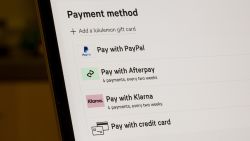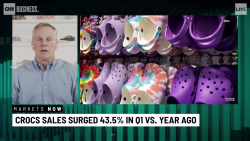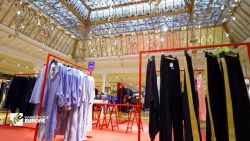Levi Strauss plans to hit the public market for the first time in 34 years, a promising sign for a troubled retail sector.
The 165-year-old company, which invented the blue jean, filed for an IPO on Wednesday. Levi’s said it could raise up to $100 million in the public offering, and will be listed on the New York Stock Exchange under the symbol “LEVI.”
The announcement shook up the retail industry Wednesday as investors scrambled to prepare for Levi’s re-appearance on the public market. Shares of American Eagle (AEO), Gap (GPS), and Abercrombie & Fitch (ANF) all dropped on the news.
Levi’s move signals that the future still looks bright for many legacy players, despite Amazon’s success in retail and the wave of bankruptcies in recent years. The company hopes that going public again will help it fund efforts to expand in the United States and overseas, as well as buy up trendy brands.
“We have significant opportunity to grow by expanding beyond our core business,” the company said in filing.
Levi’s grand plan
Levi’s outlined its growth strategy in a securities filing Tuesday. It believes it has a path forward by moving beyond jeans. It wants to sell more shirts, shoes, cold weather gear, and women’s clothes. It also hopes to grab a bigger piece of international markets, including China, India, and Brazil.
Levi’s makes close to half its sales in Europe and Asia. It believes it has a huge growth opportunity in China, which accounts for 20% of the global apparel market — but only 3% of Levi’s revenue.
Levi’s thinks it can expand in the United States too, despite a weak market for jeans. Sales of jeans fell 11% since 2013 to $16.7 billion, according to Euromonitor International. American consumers are increasingly turning toward khakis and athletic pants.
But Levi’s, with its old-school 501 jean, has avoided the downturn. Levi’s sales grew to $5.6 billion in 2018, a 14% increase from the year prior. The company is profitable: It made $285 million last year.
Under CEO Chip Bergh, Levi’s has poured money into advertising to stay connected with customers and preserve its “classic, authentic American style and effortless cool” status.
Last year, it increased its advertising budget by 24%. It has spent more to stand out at music festivals and sporting events. The company got a boost from the 2016 Super Bowl played at Levi’s Stadium, home of the San Francisco 49ers, in San Francisco. Beyonce also has helped Levi’s: In 2017, she wore Levi’s cutoff shorts at Coachella, which set the internet on fire.
The San Francisco-based company has drawn attention by taking progressive positions on issues like gay rights, gun control, and immigration.
Moving online
Levi’s wants to grow sales at its own network of stores and online. Levi’sowned 824 stores and 500 shop-in-shops in department stores, including Nordstrom, at the end of last year.
Direct sales are more profitable for Levi’s. They have made up a larger chunk of the company’s business in recent years as opens new stores and sells more online.
But the company, which also owns the Dockers brand, still makes 65% of its sales to outside retailers like Walmart and Amazon.
Levi’s only makes a fraction of sales online today, and it could struggle to make the transition, warned Matthew Kennedy, senior IPO market strategist at Renaissance Capital.
Fashion trends change quickly and boutique jean makers could challenge the company as well. Levi’s also relies heavily on selling to Walmart and Target, which have been building out their own private label clothing brands. Levi’s said retailers growing their private label brands were a risk to the company.
Levi’s first went public in 1971, but was taken private in 1985. Descendants of founder Levi Strauss still own a controlling stake, limiting outside shareholders’ ability to influence the company.

























